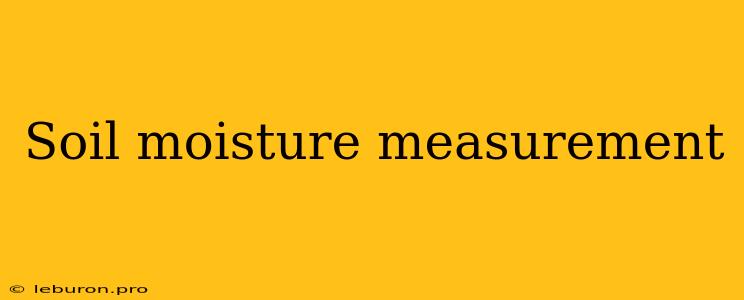Soil moisture measurement is a critical aspect of modern agriculture, environmental monitoring, and various other scientific disciplines. Understanding the water content of soil is essential for optimizing irrigation schedules, predicting crop yields, monitoring drought conditions, and studying hydrological processes. There are numerous techniques available for measuring soil moisture, each with its own strengths, weaknesses, and applications. This article delves into the various methods of soil moisture measurement, exploring their principles, advantages, limitations, and applications.
Understanding Soil Moisture
Soil moisture refers to the amount of water present in the soil. It is a dynamic variable, constantly fluctuating due to factors such as precipitation, evaporation, transpiration, and infiltration. Soil moisture is crucial for plant growth, as it provides the necessary water for physiological processes. Additionally, soil moisture plays a vital role in regulating the Earth's climate by influencing evapotranspiration rates, which impact atmospheric humidity and temperature.
Methods of Soil Moisture Measurement
Soil moisture measurement techniques can be broadly categorized into two main groups: direct methods and indirect methods.
Direct Methods
Direct methods involve physically extracting soil samples and directly measuring the water content. These methods are generally considered more accurate than indirect methods, but they are also more labor-intensive and time-consuming. Some common direct methods include:
1. Gravimetric Method:
This traditional method involves collecting a soil sample, weighing it, drying it in an oven at 105°C until constant weight, and then weighing it again. The difference between the two weights, divided by the initial weight, provides the gravimetric water content. This method is considered the gold standard for soil moisture measurement, but it is time-consuming and requires access to a laboratory.
2. Time Domain Reflectometry (TDR):
TDR is a widely used direct method that employs electromagnetic waves to measure the water content of soil. A TDR probe, consisting of metal rods inserted into the soil, emits electromagnetic pulses. The time it takes for these pulses to travel through the soil and return to the probe is proportional to the water content. TDR probes are available in various sizes and configurations, allowing for measurements at different depths.
3. Neutron Probe:
Neutron probes utilize a radioactive source to emit neutrons into the soil. The neutrons interact with the hydrogen atoms in water molecules, slowing down the neutrons. The probe measures the number of slowed-down neutrons, which is proportional to the soil water content. Neutron probes provide accurate measurements but require specialized training and handling due to the use of radioactive materials.
Indirect Methods
Indirect methods estimate soil moisture without directly extracting soil samples. These methods are typically less accurate than direct methods but are more convenient and can be used for large-scale monitoring. Common indirect methods include:
1. Electrical Conductivity (EC) Sensors:
These sensors measure the electrical conductivity of the soil, which is inversely proportional to soil moisture. EC sensors are relatively inexpensive and can be installed in various soil types. However, the relationship between EC and soil moisture can be affected by factors like soil salinity and temperature.
2. Capacitance Sensors:
Capacitance sensors measure the dielectric constant of the soil, which changes with water content. These sensors are often used in irrigation control systems and are relatively sensitive to changes in moisture levels. However, they can be affected by soil texture and temperature variations.
3. Tensiometers:
Tensiometers measure the suction pressure of water in the soil, which is related to the soil moisture tension. These sensors are primarily used to monitor soil moisture in the root zone of plants. However, they are susceptible to clogging and can be difficult to install in dense soils.
4. Remote Sensing:
Remote sensing techniques, such as satellite imagery and aerial photography, can estimate soil moisture over large areas. These methods utilize different spectral bands to identify areas with different moisture levels. Remote sensing is cost-effective for large-scale monitoring but has limitations in terms of spatial resolution and accuracy.
5. Soil Water Balance Models:
Soil water balance models estimate soil moisture based on inputs such as precipitation, evapotranspiration, and drainage. These models are typically used in hydrological and agricultural applications to predict soil moisture dynamics over time. However, they require accurate inputs and may not be suitable for all regions and soil types.
Applications of Soil Moisture Measurement
1. Agriculture:
- Optimizing Irrigation: Soil moisture measurements help farmers determine the precise amount of water needed to irrigate crops, reducing water waste and improving crop yields.
- Precision Farming: Soil moisture data can be integrated with other agricultural information to create precise fertilization and pest control plans, maximizing crop productivity and minimizing environmental impact.
- Drought Monitoring: Soil moisture sensors can detect early signs of drought stress in crops, allowing farmers to take timely action to mitigate the impacts.
2. Environmental Monitoring:
- Hydrological Studies: Soil moisture measurements are crucial for understanding the movement of water through the soil and its impact on water resources.
- Climate Change Monitoring: Soil moisture data can provide insights into the effects of climate change on hydrological processes and plant growth.
- Land Management: Soil moisture information is vital for assessing soil health, erosion risks, and the effectiveness of land management practices.
3. Engineering and Construction:
- Geotechnical Engineering: Soil moisture plays a crucial role in determining the stability of slopes, foundations, and other infrastructure.
- Construction: Soil moisture measurements are essential for managing soil compaction and ensuring optimal performance of construction materials.
Conclusion
Soil moisture measurement is an essential tool for various applications, ranging from agriculture and environmental monitoring to engineering and construction. The choice of soil moisture measurement method depends on the specific application, budget, and desired accuracy. By understanding the principles and applications of different methods, researchers, farmers, and other stakeholders can utilize soil moisture data effectively to make informed decisions and optimize resource management.
